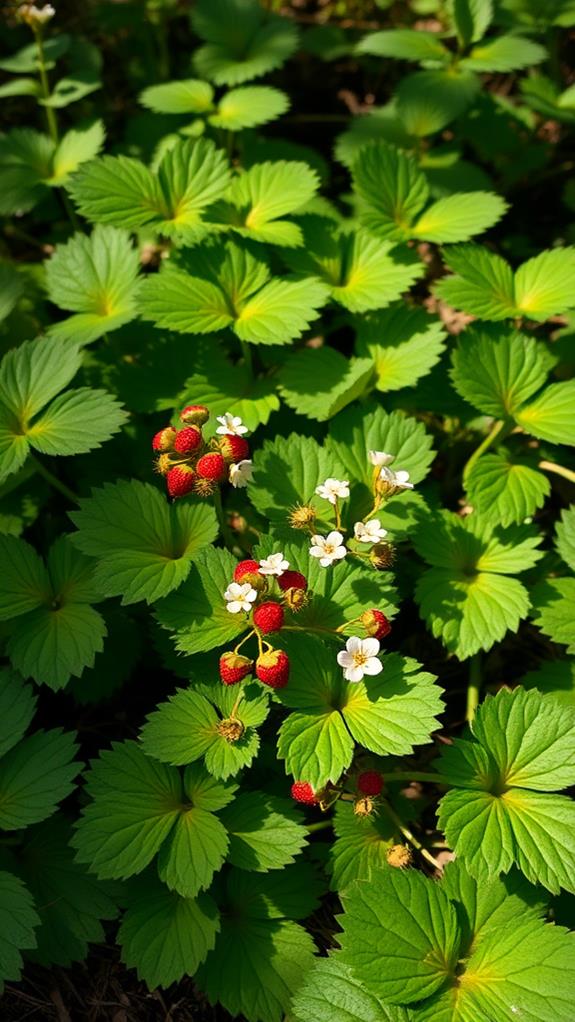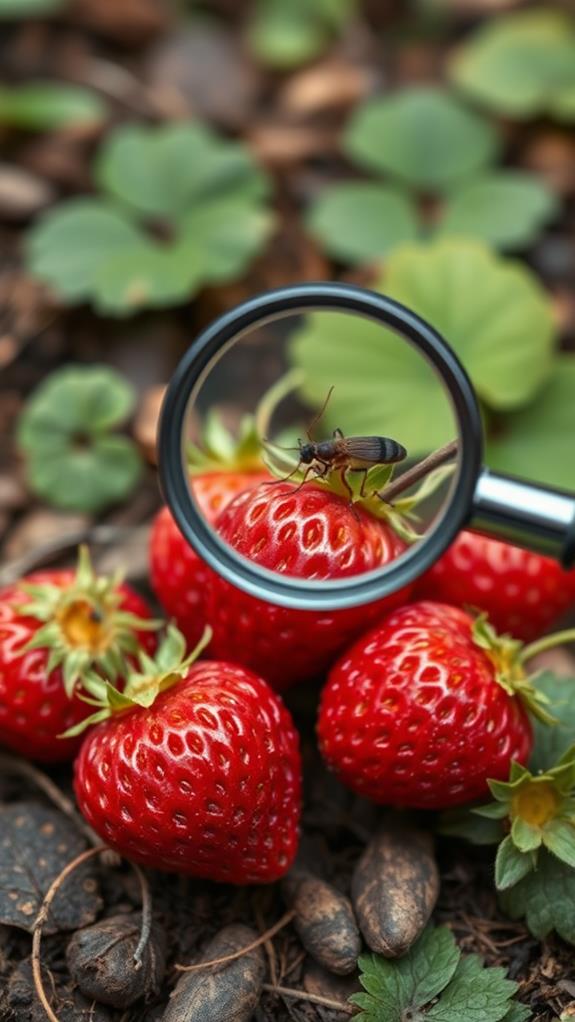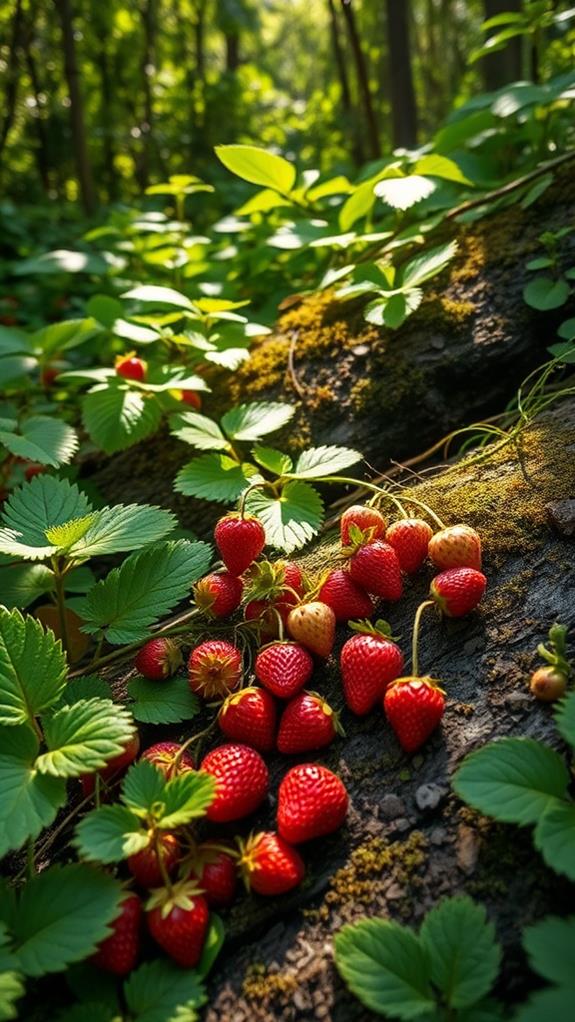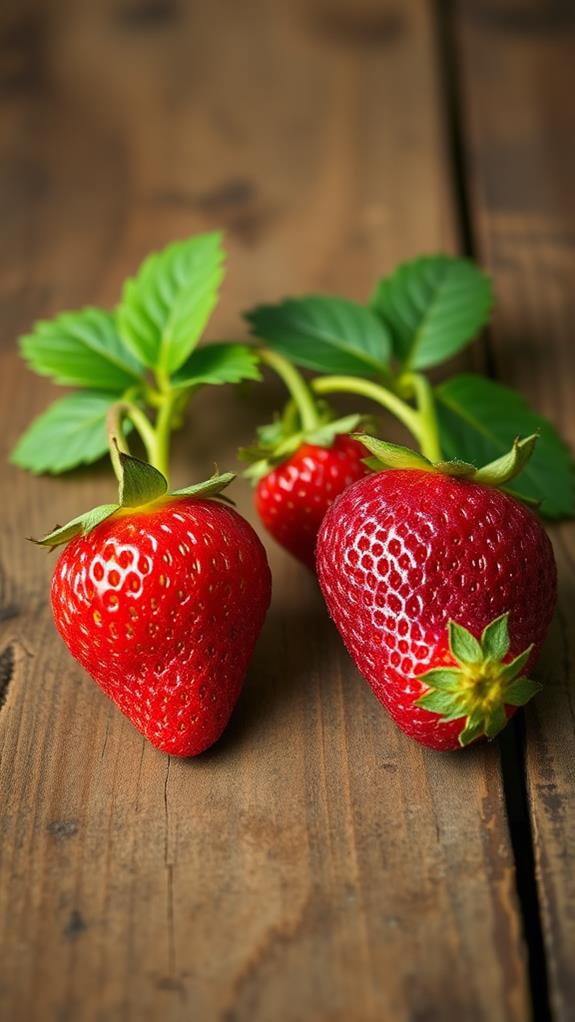Are Wild Strawberries Safe to Eat
Wild strawberries are generally safe to eat, but you need to be cautious and confident in your identification skills. These tiny, flavorful berries offer nutritional benefits, including high levels of vitamin C and antioxidants. However, they can be easily confused with toxic look-alikes, such as mock strawberries or baneberries. To guarantee safety, familiarize yourself with the distinct characteristics of wild strawberries: trifoliate leaves, white flowers with five petals, and small, conical red fruits. Always forage in clean areas away from potential contaminants, and thoroughly rinse your harvest before consumption. By following proper foraging practices and identification techniques, you can securely enjoy these natural treats. Exploring further will equip you with essential knowledge for successful wild strawberry foraging.
This post may contain affiliate links. If you make a purchase through these links, I may earn a commission at no additional cost to you. Additionally, portions of this post may be generated using artificial intelligence (AI) technology. While we strive for accuracy, please be aware that AI-generated content may not always be perfect and should be fact-checked when necessary.
The Spatula Scoops
- Wild strawberries are generally safe to eat when correctly identified and foraged from clean environments.
- Proper identification is crucial, as toxic look-alikes like baneberry can be dangerous if mistaken for wild strawberries.
- Foraging should be done away from roads, industrial areas, and treated fields to avoid potential contaminants.
- Thoroughly rinse wild strawberries before consumption to remove surface contaminants and debris.
- Wild strawberries are nutritious, containing vitamin C, manganese, antioxidants, and fiber, offering health benefits when consumed safely.
Identifying Wild Strawberries

When venturing into the wilderness, correctly identifying wild strawberries is essential for safe foraging. You'll want to look for plants with trifoliate leaves, meaning each leaf has three distinct leaflets. These leaflets are oval-shaped with serrated edges and a matte green color. The plant's stems are thin and covered in fine hairs, often creeping along the ground or forming small mounds. Much like watercress cultivation, wild strawberries thrive in specific conditions and can be grown in garden beds or containers with proper care.
Wild strawberry flowers are small and white, typically with five petals. They bloom in spring and early summer. The fruits that follow are what you're after. Unlike their cultivated cousins, wild strawberries are much smaller, usually no larger than the tip of your thumb. They're bright red when ripe and have a conical shape with tiny seeds on the surface.
Be cautious of look-alikes, such as mock strawberries (Potentilla indica). These have yellow flowers and fruits that point upward, unlike true wild strawberries. The mock variety's fruits are edible but tasteless. To guarantee you're picking the real deal, familiarize yourself with images and detailed descriptions before foraging. This practice enhances your "organic search" skills in nature, improving your ability to find and identify wild edibles accurately.
Nutritional Benefits
Wild strawberries pack a powerful nutritional punch despite their small size. They're rich in vitamin C, providing a significant boost to your immune system and helping with collagen production. You'll also find a good amount of manganese, which supports bone health and metabolism. These tiny berries are packed with antioxidants, particularly anthocyanins and ellagic acid, which may help reduce inflammation and protect against certain diseases. Interestingly, the leaves of strawberry plants are also edible and nourishing, containing even higher levels of antioxidants than the fruits themselves.
Fiber is another key component of wild strawberries. It aids digestion and can help you feel fuller for longer. They're also low in calories, making them an excellent choice for weight management. Wild strawberries contain folate, a B vitamin indispensable for cell growth and DNA formation. This makes them particularly beneficial for pregnant women.
The natural sugars in wild strawberries provide a quick energy boost without causing a dramatic spike in blood sugar levels. Their high water content helps with hydration, too. While the nutritional profile can vary slightly depending on growing conditions, wild strawberries generally offer a more concentrated dose of nutrients compared to their cultivated counterparts. This makes them a valuable addition to your diet, offering numerous health benefits in a small, flavorful package.
Potential Risks and Concerns

When foraging for wild strawberries, you'll need to be aware of potential risks. Much like bears foraging for food, wild strawberry pickers must rely on their keen sense of smell and sight to identify safe plants. Pesticide and pollutant exposure can be a concern if you're picking from areas near roads or treated fields. Perhaps the most significant danger, however, is the possibility of misidentifying the plant, as some toxic lookalikes exist in nature.
Pesticide and Pollutant Exposure
Foragers venturing into the wild should be aware of potential pesticide and pollutant exposure when gathering wild strawberries. Even in remote areas, agricultural runoff and airborne pollutants can contaminate seemingly pristine environments. You'll want to avoid collecting berries near roads, industrial sites, or actively farmed land, as these locations may have higher concentrations of harmful chemicals.
When foraging, consider the concept of bioaccumulation, where pollutants build up in plants over time. Wild strawberries, with their shallow root systems, might absorb fewer contaminants than larger plants, but they're not immune. To minimize risk, rinse your foraged berries thoroughly before consumption. This helps remove surface contaminants, though it won't eliminate chemicals absorbed into the fruit.
If you're concerned about pesticide exposure, you can employ organic pest management techniques in areas where wild strawberries grow. These methods, such as companion planting or introducing beneficial insects, can help protect the plants without resorting to harmful chemicals. By understanding these risks and taking appropriate precautions, you can enjoy wild strawberries more safely while minimizing potential health hazards associated with pesticide and pollutant exposure.
Mistaken Identity Dangers
A paramount concern when foraging for wild strawberries is the risk of misidentification. You must be absolutely certain you're picking the right plant, as some look-alikes can be harmful or even deadly. Wild strawberries have distinct characteristics, including trifoliate leaves, white flowers with five petals, and small, red berries with seeds on the outside.
One dangerous look-alike is the mock strawberry (Potentilla indica). While not toxic, it's flavorless and can cause mild digestive issues. More concerning is the potential confusion with poisonous plants like the baneberry (Actaea rubra), which has similar leaves but produces toxic red berries.
To avoid mistakes, familiarize yourself with wild strawberry features and common look-alikes in your area. Use reliable field guides or consult local experts. Consider taking a foraging class to hone your identification skills. When in doubt, always err on the side of caution and don't consume any plant you can't identify with 100% certainty. Remember, proper plant identification is vital for safe foraging, and even experienced foragers can make mistakes.
Lookalikes to Avoid
While wild strawberries are generally safe to eat, you'll need to be cautious of similar-looking plants that can be harmful. One of the most important lookalikes to avoid is the mock strawberry, also known as Indian strawberry. Although it's not toxic, it's flavorless and can be disappointing if you're expecting a sweet treat. You'll recognize it by its upward-facing flowers and fruits, unlike true wild strawberries which have downward-facing blooms and berries.
Another plant to watch out for is the baneberry, which can be deadly if ingested. Its berries are red or white and grow in clusters, unlike the individual fruits of wild strawberries. The leaves of baneberry are also more deeply serrated than those of strawberries. Woodland strawberry, while edible, is often confused with wild strawberry. It has smaller fruits and leaves, but is safe to consume. To guarantee you're picking the right plant, familiarize yourself with the distinct characteristics of wild strawberries: trifoliate leaves, white flowers with five petals, and red fruits with seeds on the surface. When in doubt, it's always best to consult a local expert or field guide before consuming any wild plants.
Foraging Best Practices

Six essential best practices should guide your wild strawberry foraging adventures. First, always obtain permission when foraging on private property. Second, correctly identify wild strawberries using reliable field guides or expert knowledge. Third, harvest sustainably by taking only what you need and leaving plenty for wildlife and plant reproduction. Fourth, avoid foraging near roads, industrial areas, or places that may have been treated with pesticides. Fifth, use clean, food-safe containers for collection. Ultimately, wash your harvest thoroughly before consumption.
To enhance your foraging experience, consider these additional tips:
| Tip | Description | Benefit |
|---|---|---|
| Timing | Forage in early morning | Fresher berries, cooler temperatures |
| Tools | Bring a berry picker | Efficient harvesting, less damage to plants |
| Clothing | Wear long sleeves and pants | Protection from insects and scratches |
Preparation and Consumption
Once you've successfully foraged wild strawberries, it's essential to prepare them properly for safe consumption. Begin by gently rinsing the berries in cool water to remove any dirt, debris, or potential contaminants. Don't soak them, as this can lead to waterlogging and loss of flavor. After rinsing, carefully inspect each berry for signs of damage or insect infestation. Remove any that appear compromised.
You can enjoy wild strawberries raw or incorporate them into various dishes. They're delicious eaten fresh, added to salads, or used as toppings for desserts. If you're planning to cook with them, consider making jams, syrups, or baked goods. Remember that wild strawberries are typically smaller and more intensely flavored than their cultivated counterparts, so you may need to adjust recipes accordingly.
It's critical to note that while wild strawberries are generally safe to eat, some people may have allergies or sensitivities. If you're trying them for the first time, start with a small amount and watch for any adverse reactions. Additionally, if you're unsure about the identification of the berries you've foraged, it's always best to consult an expert before consuming them.
Wild vs. Cultivated Strawberries

Wild strawberries and their cultivated cousins share many similarities, but they also have distinct differences that can impact your foraging and eating experience. Wild strawberries are typically smaller, with a more intense flavor and aroma. You'll find them growing naturally in forests, meadows, and along trails. Their taste is often described as sweeter and more complex than cultivated varieties.
Cultivated strawberries, on the other hand, are the ones you're likely to find in grocery stores and gardens. They're larger, juicier, and have been bred for specific traits like size, shelf life, and disease resistance. While they're generally milder in flavor, they're more consistent in taste and appearance.
When it comes to nutritional content, wild strawberries often have higher concentrations of vitamins and antioxidants due to their smaller size and natural growing conditions. However, cultivated strawberries still offer significant health benefits. If you're foraging for wild strawberries, be sure to correctly identify them and avoid areas that may have been treated with pesticides or herbicides. Cultivated strawberries are more readily available and can be grown in controlled environments, making them a reliable option for regular consumption.
Sustainability and Conservation
When you're foraging for wild strawberries, it's essential to consider your impact on the local ecosystem. Overharvesting can disrupt the balance of plant and animal species that rely on these berries for food and reproduction. To help preserve wild strawberry habitats, you should practice responsible foraging by taking only what you need and leaving plenty for wildlife and plant regeneration.
Foraging Impacts on Ecosystems
Foraging for wild strawberries can impact local ecosystems in various ways. When you collect these berries, you're removing a food source for wildlife and potentially disrupting plant reproduction. It's fundamental to understand that wild strawberries play a role in their habitat's biodiversity.
Overharvesting can lead to a decline in plant populations, affecting not only the strawberries but also the animals that depend on them. This ripple effect can alter the ecosystem's balance. Additionally, your presence in natural areas may inadvertently introduce non-native species or compact soil, affecting plant growth.
To minimize your impact, practice sustainable foraging techniques. Harvest only what you need, leaving plenty for wildlife and future plant growth. Avoid damaging surrounding vegetation and be mindful of where you step. It's also important to research local regulations and obtain necessary permits before foraging.
Preserving Wild Strawberry Habitats
For the preservation of wild strawberry habitats, conservation efforts are essential. You'll find that these delicate ecosystems face numerous threats, including habitat loss, climate change, and invasive species. To protect these environments, it's imperative to implement sustainable land management practices and create protected areas.
You can support conservation efforts by advocating for policies that limit urban sprawl and promote green spaces. Additionally, you should be aware of the impact of pesticides and herbicides on wild strawberry populations. Organic farming methods in surrounding areas can help maintain healthy habitats.
Engaging in citizen science projects, such as biodiversity monitoring, can provide valuable data for researchers and conservationists. You might also consider supporting local conservation organizations or participating in habitat restoration projects.
It's important to note that preserving wild strawberry habitats benefits not only the plants themselves but also the entire ecosystem. These habitats support pollinators, soil health, and other wildlife. By protecting these areas, you're contributing to the overall biodiversity and ecological balance of your region.
Frequently Asked Questions
Can Wild Strawberries Be Grown in Home Gardens?
Yes, you can grow wild strawberries in your home garden. They're an excellent option for gardeners looking for a low-maintenance, perennial fruit plant. Wild strawberries adapt well to various soil types and prefer partial shade to full sun. You'll find them easy to propagate through runners or seeds. While they produce smaller fruits than cultivated varieties, wild strawberries offer a more intense flavor. They're perfect for ground cover, rock gardens, or as edging plants in your landscape design.
Do Wild Strawberries Have Any Medicinal Properties?
Yes, wild strawberries do have medicinal properties. You'll find they're rich in vitamin C, which boosts your immune system. They also contain ellagic acid, a compound that may help prevent certain cancers. Wild strawberries have anti-inflammatory properties, potentially aiding in reducing arthritis symptoms. They're known to support digestive health and may help lower blood pressure. It bears remembering that while these benefits exist, you shouldn't rely on wild strawberries as a primary medical treatment.
How Long Is the Wild Strawberry Growing Season?
Have you ever wondered about the fleeting nature of wild strawberries? The growing season for these delicate berries typically spans from late spring to early summer. You'll find them flourishing for about 3-4 weeks, usually between May and July, depending on your location and climate. During this brief window, you can enjoy their sweet, tangy flavor. Remember, the exact timing can vary, so it's best to keep an eye out for those distinctive white flowers that precede the fruit.
Are There Different Varieties of Wild Strawberries?
Yes, there are different varieties of wild strawberries. You'll find several species across the world, including Fragaria vesca (woodland strawberry), Fragaria virginiana (Virginia strawberry), and Fragaria chiloensis (beach strawberry). Each variety has unique characteristics with respect to size, flavor, and growing conditions. Some wild strawberries are smaller and more intensely flavored than cultivated varieties. While they're less common, you might encounter these wild varieties during nature walks or in specialized markets.
Can Wild Strawberries Be Used in Cooking and Baking Recipes?
Picture a sun-drenched kitchen, where the sweet aroma of wild strawberries fills the air. You'll be pleased to know that these tiny, flavorful berries can indeed be used in cooking and baking recipes. They're perfect for jams, pies, tarts, and sauces. You can also add them to salads or use them as a garnish. Their intense flavor means a little goes a long way. When using wild strawberries, remember they're smaller and more delicate than cultivated varieties, so adjust your recipes accordingly.
Conclusion
You've now got the knowledge to safely enjoy nature's sweet treasure. Wild strawberries are generally safe, but like any foraging adventure, caution is key. Remember, if you're not 100% certain, it's best to leave it be. As you venture out, tread lightly on the earth's strawberry patches. By following proper identification and foraging practices, you'll not only satisfy your taste buds but also preserve these delicate ecosystems for future generations. Happy berry hunting!





